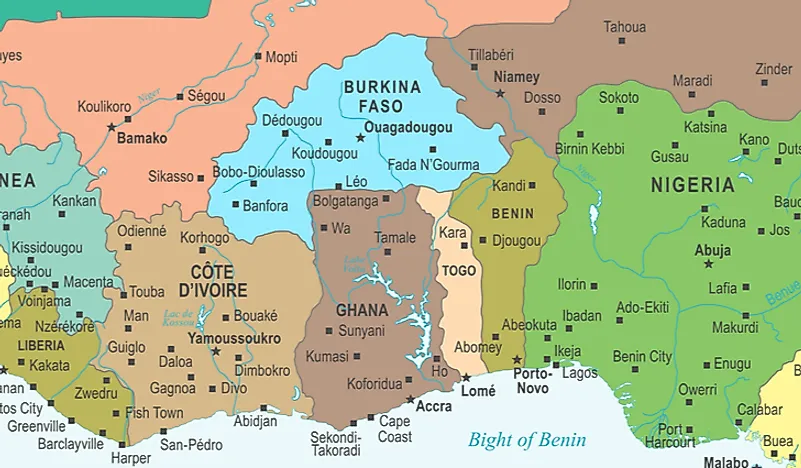Which Countries Border Togo?

Togo is a small nation situated in West Africa which occupies an area of 21,925 square miles. The country has an elongated shape, and its land border is relatively short, stretching a total of 1,023 miles in length. Togo shares its land border with three countries that bound it: Burkina Faso, Ghana, and Benin. The longest of Togo’s international borders is the Togo-Ghana border which is 545 miles in length while Burkina Faso-Togo border is the shortest of Togo’s three international borders, with a length of 78 miles. A former French colony, Togo gained independence in 1960 but retained the demarcation of the border as was defined by French colonists.
Ghana-Togo Border
Togo is bound to the west by Ghana, and the two countries are separated by a long land border. With a length of 545 miles, the Togo-Ghana border is the longest of Togo’s three international borders. The border starts at the tripoint connecting Ghana, Burkina Faso, and Togo and extends southwards to the Atlantic Ocean. The country inherited the definition of the border after it gained independence from France in 1960 and Ghana also retained the demarcation of the border upon gaining independence in 1957. The border was first demarcated during the partitioning of the Togoland in 1916 into French Togoland and British Togoland. The demarcation came in the wake of the First World War which saw Germany lose vast territories in its former colonies. Being a German colony, Togoland fell into the hands of the British and French who partitioned the colony into two. However, residents of British Togoland voted to merge with Ghana in a plebiscite held in 1956. French Togoland was later known as Togo after the abolishment of colonial rule in 1960.
Border Crossings
The primary crossing point on the border is at Aflao, a town that straddles the Togo-Ghana border. The town is well-manned, having immigration personnel drawn from the two countries who oversee the cross-border activities. The border crossing point records an immense number of crossings each day due to its proximity to Togo’s capital of Lome. Most of the border is unmarked and, therefore, porous, with smugglings of goods taking place on remote sections of the border. Due to the unmarked nature of the border, unsuspecting people and particularly tourists often find themselves across the border and in effect, breaking the law. When arrested, such people are required to pay a fine or earn jail term for making an illegal crossing on the border. Bribery is rife on the border, with security agencies from the two countries willing to take up bribes from people who make illegal crossings on the Togo-Ghana border.
Border Conflict
The two bordering countries have constantly been engaging in armed conflict along the border, with either country bombarding locations across the border. Thousands of Togo citizens crossed the border settling in Ghana as refugees in the 1990s after the army indiscriminately slaughtered civilians. By June 1993 Ghana had received as many as 0.6 million Togolese refugees which caused a humanitarian crisis along the border. The conflict resulted in Togo closing its border with Ghana.
Benin-Togo Border
Benin bounds Togo to the east. The border separating the two West African countries spans 400 miles in length. The border starts at the tripoint connecting Burkina Faso, Togo, and Benin, from where it moves south until it reaches the Atlantic Ocean. Unlike the Togo-Ghana border which is irregular, a significant section of the Benin-Togo border follows straight lines.
History
In the late 19th Century, the European powers met to discuss how they would partition Africa and establish colonies in what was known as the “Scramble For Africa.” The border delimiting Togo and Benin was first defined during this meeting. Before the Scramble, there was no border and communities currently found on opposite sides of the border lived as one in harmony as is evident in their shared cultural identity. Originally under the control of Germany, Togo would later fall into the hands of France after the First World War, and the French colonial authority decided not to change the original definition of the border as established by the Germans. Both Benin and Togo agreed to retain the colonial definition of the international border after gaining independence in the 20th Century.
Cross-Border Relations
The two countries have coexisted peacefully and have yet to be entangled in a border dispute. Togo and Benin have even come together in infrastructural projects on the border, an example of which being the Frontiere-Tohoun-Notse asphalt road which connects border towns and villages on opposite sides of the Benin-Togo border. Border security is provided by security forces from the two countries who patrol their respective sides of the border. A considerable section of the border crosses remote regions where human settlement is low. In such remote locations, the border is rarely patrolled and, therefore, susceptible to illegal border activity. Nonetheless, the Benin-Togo border is peaceful and orderly, relative to the other two international borders of Togo.
Burkina Faso-Togo Border
Burkina Faso bounds Togo to the north, and the two countries share a long land border. Starting at the Benin-Burkina Faso-Togo tripoint, the border extends west and ends at the Ghana-Burkina Faso-Togo tripoint. The Burkina Faso-Togo border is the shortest of Togo’s three international borders, stretching a length of 78 miles. The border was first demarcated in 1884 during the Scramble of Africa when the two countries were established as European colonies. Burkina Faso retained the definition of the border after gaining independence from France in 1958 (the country was then known as Upper Volta), a decision Togo also made after becoming independent in 1960. Security forces patrol the border from Togo and Burkina Faso who are tasked with curtailing illegal cross-border activities on the porous border. Crossing the border on the official border crossing points is not a difficult task. One is only required to produce the necessary documents to the customs and immigration officials stationed on the border crossing point.











